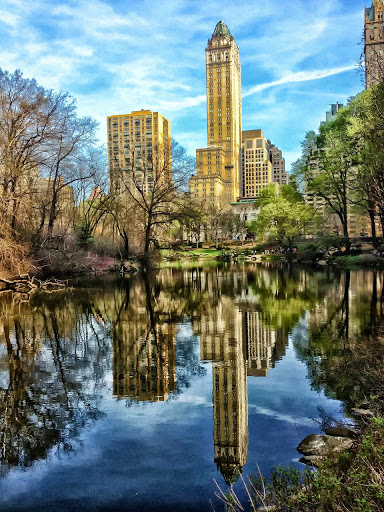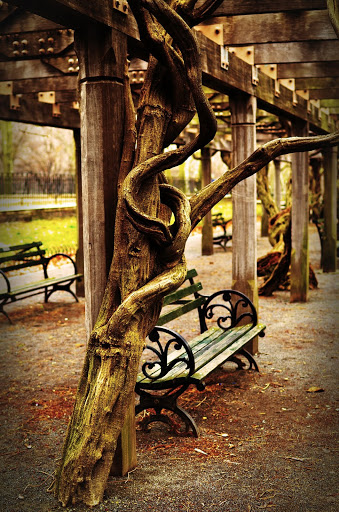When you think New York City, what comes to mind first? Central Park, of course (or, if you’re our daughter, Central Perk, and THEN Central Park).

One of our national treasures, Central Park was our nation’s first public park – and has remained free since its creation.

Central Park covers 843 acres in Manhattan, and has fountains, monuments, sculptures, play areas, wide open fields, skating rinks, pools, sports facilities and fields, fishing (!), four zoos, an aquarium, restaurants and food carts, facilities for music and theatre, water features, bridges, a castle, and countless benches for resting (and people watching, of course).

The Central Park Conservancy has five Visitor Centers: Charles A Dana Discovery Center, Belvedere Castle, Dairy Visitor Center, Chess & Checkers House, and Columbus Circle Information Kiosk.
There’s so much to do in Central Park – but here are three unusual things to do, whether you’re visiting or a local.

Take a Rickshaw Tour
There are many ways to learn about Central Park, but perhaps the most fun is via Peter Pen Tours, offering Central Park Rickshaw Tours. You won’t get hot and sweaty and tired from walking, biking, or huffing it on a walking tour – especially trying to see it all in one day (impossible, on foot; smelly, says the farm girl, on a horse drawn carriage!). Bonus for me - it's an easy way for people with mobility disabilities to get around and learn about a large area. The rickshaws are covered so you don’t get sunburned, and fit 1-3 people. If you have a bigger group, reserve a 2 (or more) rickshaws.

You’ll learn much about NYC history from your own personal guide and pedicab driver, but you’ll also discover interesting things about Central Park on a 1, 2, or 3 hour tour. Depending on the tour, you’ll visit and learn about Central Park, including Strawberry Fields, Bethesda Fountain, the Dakota, Cherry Hill, the Carousel, the Dairy, Conservatory Water, Cleopatra’s Needle, Belvedere Castle, Harlem Meer, the museum mile, and the quieter, northern side of the park. Most of all, you’ll spend time and learn from an intelligent, funny, knowledgeable local tour guide – my favorite kind of people.

Revisit your childhood at Conservatory Water
You can rent small, motorized boats to float here, in summer, and in winter, ice skate for free, both things that kids love to do, and adults love to remember doing (and doing again, with their kids). But my favorite part of childhood to revisit here is Alice in Wonderland sculpture nearby, where you can see Alice, the Mad Hatter, the Cheshire Cat, and more. The sculptures were created by José de Creeft, and were commissioned by publisher George Delacorte in tribute to his wife. They were dedicated in 1959. NYC Parks notes,
Cast by Modern Art Foundry of Long Island City, Queens, the statues represent many of Dodgson's best known creations, including the White Rabbit, the Mad Hatter, the Dormouse, and the Cheshire Cat. The central figure of Alice was based on the artist's daughter Donna, while many of the features and costumes are inspired by the earlier Tenniel illustrations. De Creeft worked in many media, and created numerous stone carvings. The Alice in Wonderland project's architect and designer were Hideo Sasaki and Fernando Texidor, who inserted plaques with inscriptions from the book in the terrace around the sculpture.
The area around the model boat pond-the scene of the fictional Stuart Little's exploits aboard a fragile craft-encompasses a cluster of monuments with themes from children's literature. Also in the park are the Sophie Irene Loeb Fountain (1936), near East 76th Street, with figures from Alice in Wonderland by Frederick G. R. Roth; on the west side of Conservatory Water the statue of Hans Christian Anderson and the Ugly Duckling (1956) by Georg John Lober; and on the east side of Rumsey Playfield the Mother Goose (1938), also by Roth. Yet it is perhaps De Creeft's Alice in Wonderland sculpture, that makes tangible the stories which sprang from the mind of Lewis Carroll, which has most captivated generations of young New Yorkers.

Go Birding
There are more birds in New York City than just pigeons and Canadian geese (and the slew in the zoo) – 230 different species!
One species, the common starling, was released into Central Park in 1890 by the president of the American Accilmatization Society, which sought to “introduce into North America every bird mentioned by Shakespeare,” notes writer Ted Gup. This is one well-meaning quest gone awry, with starlings (along with house sparrows, another one they brought over) being, Gup writes, “one of the costliest and most noxious birds on our continent.”
Want to learn about common starlings and the 229 other bird species in the park? Check out a Discovery Kit, free of charge, from one of the Central Park Conservancy Visitor Centers. These are available from 10am-3pm, and include important things for birding (and discovering wildlife, trees, and plants, as well): binoculars, a guide, maps, and drawing materials. Bring your own sense of curiosity, sunscreen, a hat, and some good walking shoes.


Common starlings. They're so pretty! How could they be a nuisance? Photos Wikimedia Commons: Mosma, Pierre Selim
Learn more:
New York City Department of Parks & Recreation
Central Park Conservancy

